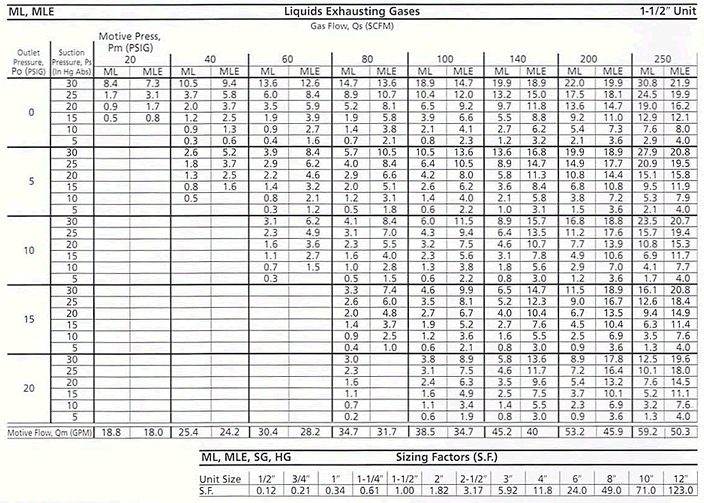How to Size Liquid Motive Eductors for Exhausting Gases
 Using the Eductor Models ML and MLE
Using the Eductor Models ML and MLE
Exhausting is a continuous operation of removing gases at a constant suction pressure. The units are sized based on a desired flow rate of gas through the eductor.
- Step 1 Before beginning to do the actual sizing, convert all pressure and flow to the units used in the sizing table. (If sizing is done regularly with other units, request a special sizing table from us.)
- Step 2 First find the value that is equal to or greater than your system back pressure in the Outlet Pressure (Po) column. After locating the correct value on me sizing table. use this section of the table t0 size the unit.
- Step 3 Locate the pressure that is equal to or higher than your desired suction pressure (Ps) for the outlet pressure found in Step 2. If the pressure is between two values on the sizing table. you can interpolate between them. If you don't wish to interpolate, the higher pressure will give a conservative estimate.
- Step 4 In the row for suction pressure (Ps), locate the column where the motive pressure (Pm) is equal to your motive pressure in the flowing condition. If the pressure is between two levels on the sizing table, you can interpolate between the values. If you don't wish to interpolate. the lower pressure will give a conservative estimate.
- Step 5 Divide your desired flow (Qs) rate by the flow rate of each model. This will give you a desired Sizing Factor (S.F.) for each model. Pick a unit with a S.F. (sizing factor) that is equal to or larger than the one calculated above. Generally, the model with a larger suction capacity will be the more efficient unit to calculate the actual gas flow, multiply the S.F. of the selected model by the suction flow (Qs) of the model in the table.
- Step 6 Calculate the amount of water required to operate the eductor by multiplying the GPM in the Motive Flow (Qm) row by the S.F. of the unit selected.
- Note 1: In many cases. the capacity of the MLE and ML units are close. Both should be sized to find the proper unit for the application.
- Note 2: When using liquids to pump gases. the eductor acts as a "volume displacing device. Therefore. the weight of the gas has only minimal effect on the performance of the eductor.

 Example:
Example:
Desired Suction Flow, Qs = 5 Lb/Hr air
Desired Suction Pressure, Ps = 5 In Hg Vac
Motive Water Pressure, Pm = 40 PSIG
Outlet Pressure, Po = 11 Ft Head
- Step 1 Convert the figures from given units to units used in the performance tables.
- 5 Lb/Hr x 13.35 Ft3/Lb/60 Minutes = 1.1 SCFM Air
5 In Hg Vac = 29.92 In Hg Abs - 5 in Hg = 24.92 In Hg Absolute
40 PSIG is available
11 Ft Head/2.31(Ft/PSIG)= 4.8 PSIG - Step 2 Look down the Outlet Pressure (Po) column until the row is reached that has 5 PSIG outlet pressure.
- Step 3 locate the suction pressure (Ps) that is equal to the desired suction pressure for the chosen outlet pressure. In this case, go 10 the section with a suction pressure of 25 In Hg Abs.
- Step 4 Find the column in the 25 In Hg row that has a motive pressure (Pm) of 40 PSIG.
- Step 5 Divide the suction flow desired by the Tabulated Suction Flow of each of the units to determine the desired S.F. 1.1 SCFM Desired/1.8 ML Tabulated Suction Flow = .65 Desired S.F. | 1.1 SCFM Desired/3.7/MLE tabulated flow = .30 Desired S.F. (sizing factor)
- From the S.F's below, it appears that the MLE will be more efficient. The 1" unit has a S.F. of .34. When we multiply the S.F. by the suction flow for the 1-1/2" unit, we find an actual suction flow of: .34 x 3.7 = 1.3 SCFFM Actual Suction Flow
- Step 6 The water needed 10 operate the MLE 1" will be 24.2 GPM x .34 S.F. = 8.2 GPM.

